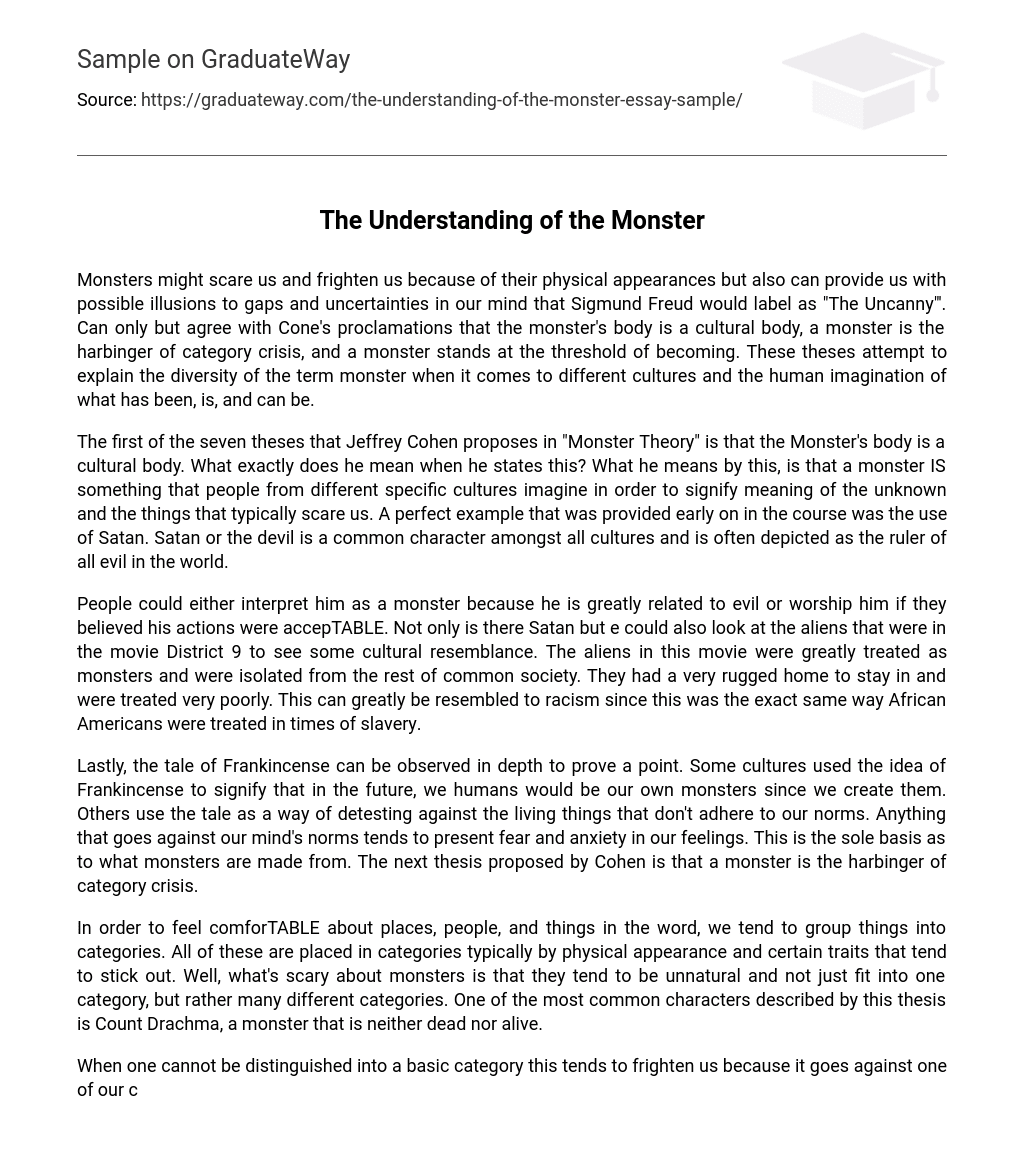Monsters might scare us and frighten us because of their physical appearances but also can provide us with possible illusions to gaps and uncertainties in our mind that Sigmund Freud would label as “The Uncanny”‘. Can only but agree with Cone’s proclamations that the monster’s body is a cultural body, a monster is the harbinger of category crisis, and a monster stands at the threshold of becoming. These theses attempt to explain the diversity of the term monster when it comes to different cultures and the human imagination of what has been, is, and can be.
The first of the seven theses that Jeffrey Cohen proposes in “Monster Theory” is that the Monster’s body is a cultural body. What exactly does he mean when he states this? What he means by this, is that a monster IS something that people from different specific cultures imagine in order to signify meaning of the unknown and the things that typically scare us. A perfect example that was provided early on in the course was the use of Satan. Satan or the devil is a common character amongst all cultures and is often depicted as the ruler of all evil in the world.
People could either interpret him as a monster because he is greatly related to evil or worship him if they believed his actions were accepTABLE. Not only is there Satan but e could also look at the aliens that were in the movie District 9 to see some cultural resemblance. The aliens in this movie were greatly treated as monsters and were isolated from the rest of common society. They had a very rugged home to stay in and were treated very poorly. This can greatly be resembled to racism since this was the exact same way African Americans were treated in times of slavery.
Lastly, the tale of Frankincense can be observed in depth to prove a point. Some cultures used the idea of Frankincense to signify that in the future, we humans would be our own monsters since we create them. Others use the tale as a way of detesting against the living things that don’t adhere to our norms. Anything that goes against our mind’s norms tends to present fear and anxiety in our feelings. This is the sole basis as to what monsters are made from. The next thesis proposed by Cohen is that a monster is the harbinger of category crisis.
In order to feel comforTABLE about places, people, and things in the word, we tend to group things into categories. All of these are placed in categories typically by physical appearance and certain traits that tend to stick out. Well, what’s scary about monsters is that they tend to be unnatural and not just fit into one category, but rather many different categories. One of the most common characters described by this thesis is Count Drachma, a monster that is neither dead nor alive.
When one cannot be distinguished into a basic category this tends to frighten us because it goes against one of our common norms. He breaks our human-made laws of nature. Along with the violations of our norm groups, monsters also tend as an act to forewarn our cultures of crisis. The creator of Frankincense can be seen as an act to caution us about he growth and use of technology. It might make us begin to create monsters of our own or see ourselves turn into monsters. As Poole states in Monsters in America, “… Imagine a threat created by a mad scientist whose moral presumption and lack of respect for human life creates monsters. “(1 05) He describes to us that what we should really fear is the scientists who tend to experiment against common physics. We could be one bad catastrophe away from our doom. Lastly, Cohen provides us with the thesis the monster stands at the threshold of becoming. Everyone has their own basic understanding of knowledge about what is accepted and known. How about the unknown or the “The Uncanny’? The fear of the unknown is one of the greatest that strikes humanity.
People don’t like to leave things unquestioned or unanswered. This is where the role of a monster is suggested to take part. In different cultures different monsters are created in order to fill these gaps and attempt to give an answer to some questions. An example where this is proven true is Big Foot and the Loch News Monster. Many people have claimed to have seen or encountered these heralded monsters, but there has been nearly no alteration of this therefore this strikes fear into our minds since it is a situation we don’t know.
Nowadays in our society technology forms a huge role in attempting to answer our unanswerTABLE questions. It is slowly beginning to take over our society and bringing forth the opportunity for people to do things that were unimaginTABLE. In the story of Frankincense, this is where we are warned of what technology can do to us. Yes, it can be the foundation of great achievements and discoveries, but it also could be the downfall of us all. The description of a monster brought to us by Jeffrey Cohen in “Monster Theory’ based off his seven theses stands very true.





